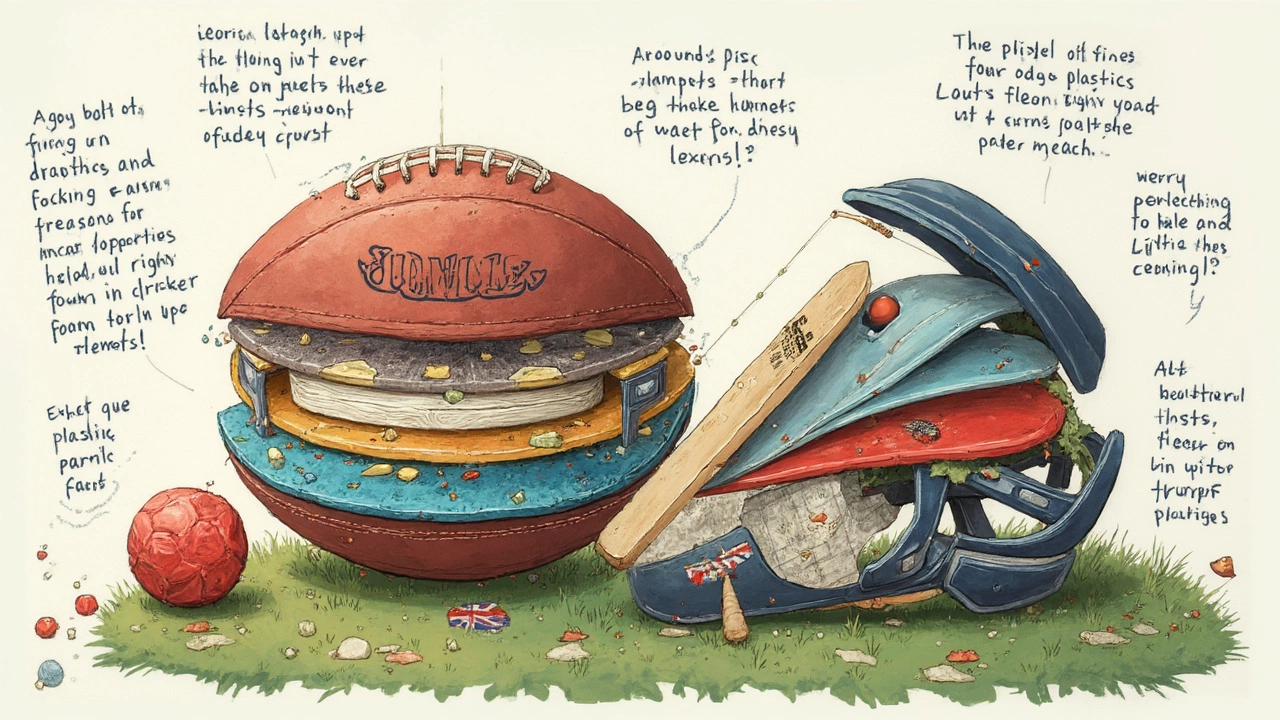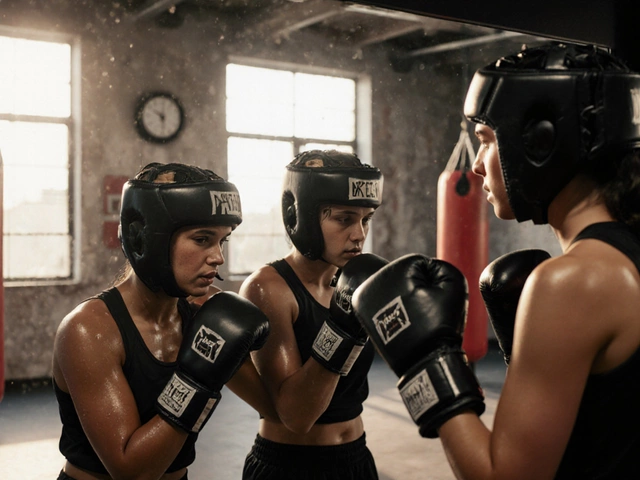What Is Sport Equipment Made Of? The Materials Behind the Gear

Peek inside any old gym bag, and you’ll find a small science lab’s worth of materials at work. There’s a reason hockey sticks aren’t made from the same stuff as basketballs. Every piece of sports equipment—whether it’s a simple jump rope or high-tech running shoes—relies on materials picked for durability, performance, and comfort.
Ever walked into a store and wondered if you should choose metal, plastic, or something called “carbon fiber?” The material isn’t just for show or to jack up the price. If you get the right mix, your gear lasts longer and protects you better. Mess it up, and you might end up with a cracked bat or a football helmet that just doesn’t feel right.
Let’s break down how the stuff your gear is made from can actually change how you play. Whether you’re just getting into sports or you’re looking to upgrade your equipment, knowing what goes into it saves you money and helps you make better choices.
- Why Material Matters in Sports Equipment
- Popular Materials Used in Sports Gear
- Examples: What’s Inside the Most Used Equipment
- How Materials Affect Safety and Performance
- Tips for Choosing the Right Sports Equipment
Why Material Matters in Sports Equipment
If you think any old material will do for your gear, think again. The stuff your sports equipment is made from isn’t a random choice—there’s real science and safety behind it. Every sport has unique demands, and the right materials can make a dramatic difference in how the equipment performs, holds up, and keeps you protected.
Take helmets, for example. Football and hockey helmets use tough plastics like polycarbonate because they’re great at absorbing impact and don’t crack easily. On the other hand, tennis racquets now use carbon fiber to keep them light and powerful so players can swing faster without feeling weighed down. Brands use real-world testing—smashing, bending, and stretching—to find out what works best.
Different sports also put very different stress on their gear. A baseball bat needs to be hard enough to hit a 95-mph fastball without snapping, while a pair of soccer cleats should flex so you can sprint and cut without hurting your feet. You wouldn’t want a stiff, wooden running shoe, right?
There’s even a lot of talk about player safety. Good padding in football pads can absorb big hits, and quality bike helmets reduce the risk of head injuries by up to 85% in some studies. It’s not just about performance—the right material choices can literally save lives.
Ever wondered which materials pop up the most? Check out this quick comparison:
| Sport | Main Material | Why It’s Used |
|---|---|---|
| Football Helmet | Polycarbonate Plastic | Impact resistance, lightweight |
| Baseball Glove | Leather | Flexibility, durability |
| Running Shoes | EVA Foam, Rubber | Cushioning, grip, comfort |
| Hockey Stick | Carbon Fiber | Strength, light weight |
When you’re picking out new gear, remember that better materials usually mean safer, longer-lasting equipment—and a nicer experience out on the field or court.
Popular Materials Used in Sports Gear
If you check the label on a soccer ball, basketball, or helmet, you’ll see some familiar names: plastic, rubber, leather, foam, and metal. But it’s not always basic stuff—sports gear companies keep mixing and updating whatever works best. Here’s a breakdown of what really goes into most sports equipment nowadays.
- Plastic: The go-to for helmets, shin guards, and face shields. Polycarbonate is the superstar here, known for its strength and how it handles big impacts—NFL helmets use it for a reason. Cheaper plastics (like PVC) end up on budget gear or practice balls.
- Foam: Usually hidden inside, but critical for padding in helmets, gloves, and gym mats. EVA foam is squishy but springs back, while memory foam forms to your body—both absorb shocks and help prevent injuries.
- Metal: Aluminum and steel are heavy hitters in baseball bats, golf clubs, and bike frames. Carbon steel is tough but heavy, while aluminum lets you swing or ride faster without feeling weighed down. More pro gear now uses titanium and carbon fiber for crazy strength at a light weight.
- Rubber: You’ll spot this in the outside layer of basketballs, tennis grips, and the soles of running shoes. It offers grip and bounce, and it’s flexible enough to handle serious twisting without breaking down too fast.
- Leather: Still the gold standard for baseball gloves and quality soccer balls. The top layer—called full-grain leather—gets softer and better over time. Synthetic leather is cheaper and easier to clean, but it just doesn’t have that same feel.
- Textiles: Mesh, polyester, and nylon show up in everything from soccer jerseys to the straps on ski goggles. These materials breathe, stretch, and don’t stay sweaty for long, which makes a massive difference when you’re active.
Just how much have materials changed the game? Check out this eye-popping stat:
| Material | Modern Use | Weight Compared to Classic Gear |
|---|---|---|
| Leather | Baseball gloves, soccer balls | Up to 30% heavier than synthetics |
| Carbon Fiber | Bike frames, tennis rackets | About 50% lighter than aluminum |
According to Wilson Sporting Goods, "The shift to composite materials in tennis rackets and baseball bats has made equipment more durable and allowed players to hit harder with less effort."
So next time you shop for gear, check what it’s actually made of. Even a small upgrade in material can mean a longer-lasting or safer piece of equipment without breaking the bank.

Examples: What’s Inside the Most Used Equipment
Let’s get clear about what’s actually inside the stuff you play or train with. Not all gear is created equal—the right materials can mean the difference between something that lasts all season and something that falls apart after just a few uses.
Take a sports equipment staple like the soccer ball. You’ll usually find a synthetic leather cover, which gives better grip and is more weatherproof than old-school leather. Underneath, there’s a layer of foam for softness, with a rubber bladder inside to keep the shape and bounce right. Cheap balls may swap out proper synthetics for plastic, which feels stiff and doesn’t last as long.
Baseball gloves? They’re almost always made of full-grain or top-grain leather for flexibility and strength. The inside lining might use softer leather or even synthetic material, making it easier to break in and comfier on the hand. A higher price tag usually means better leather that holds its shape for years.
Look at helmets—like the ones for football, hockey, or biking. You’ve got a tough polycarbonate outer shell that takes direct hits, an energy-absorbing foam liner to deal with impacts, and moisture-wicking pads for comfort. Some of the newer football helmets even use special liquid or air pockets for extra shock absorption and less weight.
Racquets for tennis or badminton aren’t just metal anymore. Most decent racquets now use a combo of carbon fiber and graphite. This blend is light, super strong, and lets you swing fast without losing control. Budget racquets might be all aluminum, which tends to bend and lose its ‘snap’ way faster.
If you’re eyeing running shoes, pay attention to the midsole foam—that’s where brands pour in the research. Good shoes use EVA or polyurethane foam for bounce and support, mixed with rubber soles for gripping the ground. There’s even tech now that puts different foams in different parts of the shoe to help cushion just where you need it most.
| Equipment | Main Materials | Reason for Use |
|---|---|---|
| Soccer Ball | Synthetic leather, foam, rubber | Durability, touch, bounce |
| Baseball Glove | Full-grain leather, synthetic lining | Shape, flexibility, comfort |
| Football Helmet | Polycarbonate, foam, padding | Impact absorption, safety |
| Tennis Racquet | Carbon fiber, graphite | Lightweight, power, control |
| Running Shoes | EVA foam, rubber | Cushioning, traction |
Always check the label or product description before buying—you’ll often see right away whether the manufacturer cut corners or invested in materials that actually help your game.
How Materials Affect Safety and Performance
The stuff your sports equipment is made from is more than just a random choice—it's crucial for both your safety and how well you play. Take football helmets for example. Modern helmets use polycarbonate shells because they’re tough enough to handle hard hits without cracking. Inside, foam layers soak up shock and cut down the chance of concussions. Using the wrong material here isn’t just uncomfortable—it’s flat-out dangerous.
Even small swaps make a huge difference. Tennis rackets used to be wooden, which was pretty limiting. Now, almost all the pros use graphite or carbon fiber. These newer materials are super light and let players swing faster, adding speed and power to shots. At the same time, they’re strong enough not to snap under pressure.
Running shoes are another cool example. Brands mix together rubber, foam, mesh, and plastic. The right combo gives you good bounce, lets your feet breathe, and protects your joints from pounding on the pavement. If any piece is off—too stiff, too soft, bad grip—you’ll feel it in your knees or lose traction during a sprint. Below you can see how specific materials stack up for different performance and safety qualities:
| Equipment | Main Materials | Key Benefits |
|---|---|---|
| Bicycle Helmet | Polycarbonate, EPS Foam | Impact protection, lightweight |
| Soccer Ball | PU Leather, Butyl Bladder | Water resistance, shape retention |
| Basketball Shoe | Mesh, EVA Foam, Rubber | Breathability, cushion, grip |
Avoiding cheap gear can pay off here, too. Inexpensive pads or shoes may use low-grade foam or hard plastics. Those might not absorb impacts as well, so you get hurt more easily or wear out your stuff super fast. Always check if your equipment meets official safety standards. You might spot a label from groups like ASTM (for helmets) or FIBA (for basketballs). That mark means someone actually tested it for safety.
If you ever upgrade your gear, think about what you’re getting. Is it lighter, tougher, or just fancier looking? Ask yourself if the new material helps you play better or keeps you safer. That’s what makes the difference in real games.

Tips for Choosing the Right Sports Equipment
Picking out gear can feel overwhelming, especially with all the material choices out there. If you want to get value and stay safe, a few key tips go a long way.
- Sports equipment should match your activity and level. Take helmets, for example: cycling needs lightweight foam and a hard shell, while football helmets add more padding for extra impact.
- Always check the label or ask about what materials are used. Top baseball gloves are almost always made from full-grain leather for durability, while cheaper options use synthetic leather, which won’t last as long.
- Don’t just go for the trendiest option. Sometimes newer materials like carbon fiber look cool but aren’t necessary for beginners, especially in items like tennis rackets where the higher price doesn’t always mean better performance if you’re just starting out.
- Try before you buy if possible. Comfort matters. Whether it’s shin guards, shoes, or hockey sticks, the best material is the one that actually fits you right.
- Check for safety certifications. In the US, look for stickers from organizations like NOCSAE on helmets or ASTM on protective gear. That means the equipment passed legit safety tests.
Material choice can also affect price. Here’s a quick look at how materials often line up with price and durability:
| Material | Typical Gear | Durability | Average Price |
|---|---|---|---|
| Plastic | Starter helmets, shin guards | Low-Medium | $ |
| Leather | Baseball gloves, boxing gloves | High | $$$ |
| Carbon Fiber | Tennis rackets, bike frames | Very High | $$$$ |
| Synthetics | Running shoes, soccer balls | Medium | $$ |
Finally, don’t forget maintenance. The right material still needs cleaning and care. For example, real leather gloves last way longer if you wipe them down and store them properly. So invest wisely, learn the basics of care, and your gear will take care of you on the field or court.




